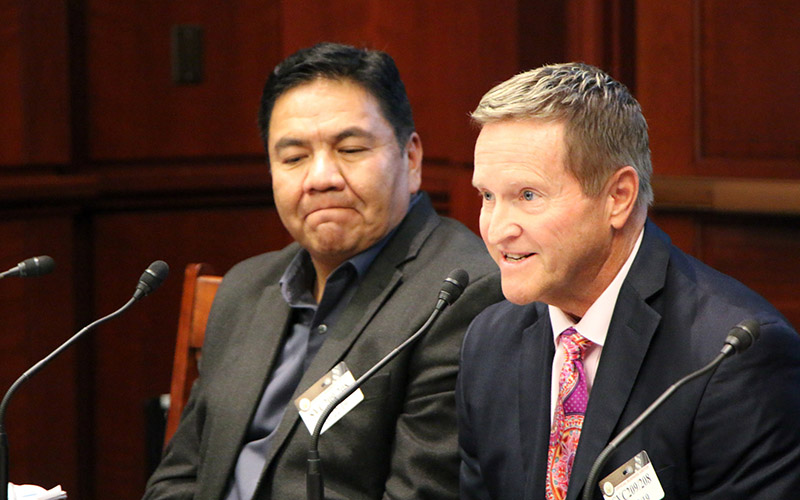WASHINGTON – More than three months into the school year, Chinle Unified School District still has teaching vacancies to fill and many of the teachers it does have on payroll do not have a standard teaching certificate.
But that’s better than it was at the start of the year, and Chinle Associate Superintendent Doug Clauschee is confident things are going to keep getting better.
Clauschee joined Steve Larson, director of the Arizona Department of Education’s educator and school excellence division, on a panel in Washington Tuesday to talk about the challenges of recruiting and retaining teachers. The two said Arizona has made some strides in that area, but concede there is still a long way to go.
“I don’t see them as being fixed by 2020, but I think we’ll take steps in the right direction,” Larson said.
It’s a particular problem in Arizona, where nearly 21% of all teacher positions were vacant at the end of August, according to a survey by the Arizona School Personnel Administrators Association.
Almost half of all teachers who were on the payroll then did not meet the state’s teaching certification standards, the survey said. And 427 teachers either never showed up or quit by the end of August, it said, with the majority of those being certified teachers.
Low teacher pay, lack of resources and sometimes remote school districts are often cited as reasons for the state’s inability to recruit and keep teachers.
One solution is the state’s 20×2020 plan. Passed in the wake of last year’s #RedforEd teacher protests, it called for improvements to state school funding, specifically a 20% raise for teachers phased in by the 2020-21 school year.
Clauschee said his district has made great strides in improving salaries and benefits packages. He said the district started the school year with 25 vacancies, but has just six classrooms that need to be filled now, nine weeks into the school year.
But recruitment and retention remain difficult for Chinle, a sparsely populated area without many amenities to attract newcomers and entice them to stay, he said.
The Chinle school district is located on the Navajo Nation, just west of the Four Corners. Clauschee said his schools serve approximately 3,800 students in an area that covers nearly 600 square miles.
Many of the openings in the district have been filled by emergency teachers, but that is less disturbing to him than a vacancy.
“Some of those positions are emergency teachers but I think if you support those teachers in the classroom with instruction, I think they can do just as good of a job as a certified teacher,” said Clauschee.
He believes the key to long-term teacher retention lies within Navajo Nation.
“What we’ve found is the homegrown teacher is where the success lies and creating opportunity for our own community members who hold bachelor’s degrees or master’s degrees and getting them into the teaching field has been very beneficial for us,” he said.
Larson said improving recruitment and retention is one of the highest priorities for Arizona Superintendent of Public Instruction Kathy Hoffman – pointing to his next job as director of recruitment and retention as proof. Hoffman created the position specifically to address those issues, he said.
-Cronkite News video by Hannah Ehrlich
Larson said the biggest obstacle remains low salaries – a National Education Association report in March said the average teacher salary in Arizona for 2017-18 ranked 45th in the nation.
He acknowledged the strides made by the 20×2020 plan, which he called a step in the right direction. But Larson said another challenge he will take on in his new role is a lack of administrative support for teachers once they are on the payroll.
“The other piece of it is a lack of support for the administrators of the teachers in the classroom and we’re working on that as well in our own office,” he said before the panel discussion hosted by WestEd and American Institutes for Research.
Despite its difficulties, Clauschee said the Chinle school district has been able to improve its reading and math scores in three years – something he attributes to supporting teachers in the classroom.
“Chinle has been one of the persistently low performing subgroups in Arizona and so we want to provide high-quality instruction, and that only means supporting teachers in the classroom,” he said.



